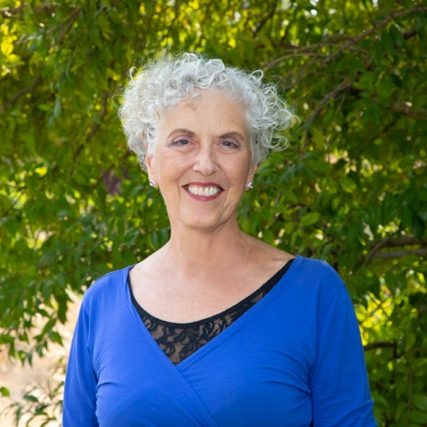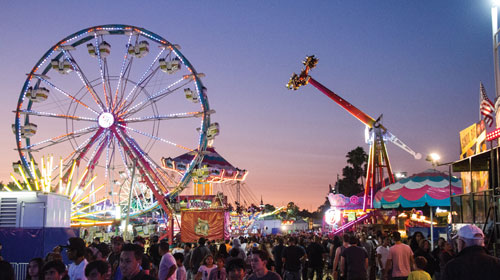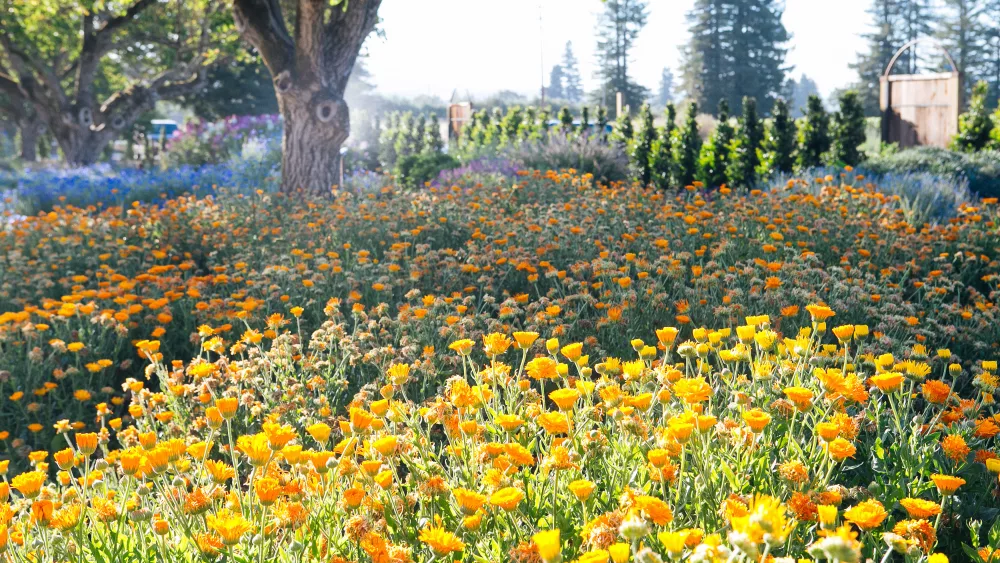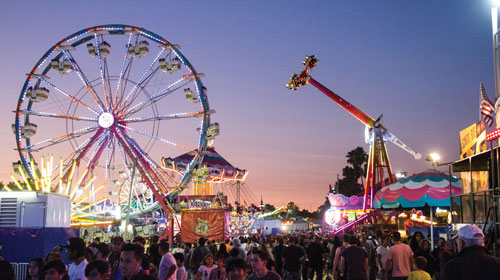
A Ferris wheel, cotton candy, corn dogs, Aunt Betty’s quilts, mom’s blackberry jam, a heifer in a halter being led by a boy wearing a 4-H cap—these are images that may come to mind when one hears the words “county fair.” The yearly tradition also gives agriculture a boost by showcasing its products and hosting a high-profile marketplace.
Additionally, fairs provide hands-on education for children about where our food comes from, offer an array of music and entertainment and stimulate commerce by supplying employment, directly and indirectly, through businesses and services impacted by fair attendance. But there’s still more happening behind the scenes at North Bay fairgrounds, keeping them viable and relevant. Fairgrounds in Marin, Sonoma and Napa counties have become year-round enterprises and offer commercial and cultural events our farming ancestors could not have imagined, preserving the traditional fair experience in the process.
Sonoma-Marin Fairgrounds & Event Center
Fair attendance: 58,482
Fair revenue: $625,838
Total number of exhibits: 3,420
Total prize money awarded: $36,396
Youth scholarships awarded: $6,000
Temporary hires just for the fair: 135
Size of grounds: 60 acres
[Box stats for individual fairs are for most recent year available]
The correct moniker for the Sonoma-Marin Fair is “state fair” rather than “county fair” since it’s a part of the 4th District Agricultural Association (DAA), a division of the California Department of Food and Agriculture (CDFA). The Sonoma-Marin Fair embodies the tradition of promoting and educating about agriculture, and proudly displays the diverse talents, interests and accomplishments of its community. But equally important, this 80-year-old fair—and the entire Network of California Fairs—provides a tremendous positive ripple effect of economic benefits.
 Allison Keaney, Ph.D., chief executive officer of the Sonoma-Marin Fairgrounds and Event Center, points to the 2015 Economic Impact Study of California’s Fairgrounds put out by the CDFA’s Fairs and Exposition Branch. “The most recent numbers are from 2015, because it takes time to calculate past the immediate effects,” she says. According to the report, $9,945,000 in spending was generated that year by nearly 349,000 patrons as well as the organizers, service providers, vendors and concessionaires who supported the Sonoma-Marin Fair. The equivalent of 146 jobs was created, with labor income of approximately $3,302,000. The entire California fair network produced a whopping $3.9 billion in economic activity benefiting local, state and global economies. The Board of Equalization estimated the total sales and use tax revenue for the California Network of Fairs was approximately $66 million. While the numbers are exciting, Keaney’s passion manifests in how the expansion of the five-day fair into a year-round center for educational and cultural events impacts the heart and spirit of Petaluma and the neighboring areas.
Allison Keaney, Ph.D., chief executive officer of the Sonoma-Marin Fairgrounds and Event Center, points to the 2015 Economic Impact Study of California’s Fairgrounds put out by the CDFA’s Fairs and Exposition Branch. “The most recent numbers are from 2015, because it takes time to calculate past the immediate effects,” she says. According to the report, $9,945,000 in spending was generated that year by nearly 349,000 patrons as well as the organizers, service providers, vendors and concessionaires who supported the Sonoma-Marin Fair. The equivalent of 146 jobs was created, with labor income of approximately $3,302,000. The entire California fair network produced a whopping $3.9 billion in economic activity benefiting local, state and global economies. The Board of Equalization estimated the total sales and use tax revenue for the California Network of Fairs was approximately $66 million. While the numbers are exciting, Keaney’s passion manifests in how the expansion of the five-day fair into a year-round center for educational and cultural events impacts the heart and spirit of Petaluma and the neighboring areas.
“A fair is not just the locals who come to the carnival and shows,” she says. “It’s those who visit from miles around, and the hundreds of vendors and entertainers who utilize the amenities of our community. They eat in our restaurants. They stay in our hotels. They shop. They buy gas.”
Keaney grew up in Novato and was a 4-H leader in Petaluma and program representative for Marin County 4-H. Fairs run in the family, with her parents having shown animals at the Sonoma-Marin Fair. Her husband and children have as well, and Keaney’s first concert experience was at the fair when Huey Lewis and the News came to town in 1984. “I’ve only been CEO for a year, but I’ve been involved for a long time. Coming here to work was a happy and natural thing for me to do.”
The Sonoma-Marin Fair celebrated its 80th anniversary in June 2019, announcing the theme, “Eight Decades of Fun” through every promotional means at its disposal: email, Facebook, the Fair marquee and mailing list. “The exhibits coordinator made personal visits to Future Farmers of America and 4-H meetings to discuss what was new,” Keaney says. “We did a newsletter early because some projects take a while to execute. It gives kids something to do over Christmas break.”
The fair’s theme was woven throughout the exhibition buildings and grounds, always with a sense of history and in keeping with the traditional aspects of old-time country gatherings. For example, the 1940s were reflected in the barn and garden area, highlighting food production (including Victory Gardens) and farming practices at that time. The ’50s theme inspired food competitions with a “Make it with Spam” as well as a Jell-O mold and a mac-and-cheese contest. Herzog Hall featured Pop Art and Minimalism movements, and a Paint-by-Number competition—all popular in the 1960s.
“And so it went, highlighting the ’70s, ’80s, ’90s and into the next century,” Keaney explains. “Fairs and expositions have always shown the latest thing, what was going to make life easier on the farm; our grandfathers would go to check out the most modern tractor. This year, Petaluma transit brought their hybrid bus because people here would love to be less dependent on cars. We ask the question, ‘What does each community have interest in?’ and that’s what will be at the fair.”
According to Keaney, the fair is an ideal place for families to enjoy an outing together, and every attempt is made to keep it affordable, with one price of $18 (except for a Sprint Car Race, and those vendors with extra-charge events). “We have a little of everything: a huge range of exhibits, rides, livestock shows, kids activities, and our specialty—top-name, main stage entertainment. All this in a space manageable for a family. We’re a good size, but not overwhelming.”
Also new for the Sonoma-Marin Fair is special staff training to help families with members who are mobility or sensory challenged such as a child with autism or an adult with PTSD. Keaney’s staff went through this training in May to better identify situations where visitors may be struggling with sensory overload, and to help them find a quiet place to relax and reset. The ultimate goal is to help these individuals stay at the fair longer and enjoy it more. The Sonoma-Marin fairgrounds, like its local counterparts, have evolved into a multi-purpose event center that bustles with activity year-round. Accessibility and a variety of spaces, plus reasonable rates, allow families to celebrate birthdays, anniversaries, quinceañeras, graduations, religious services and more at these locations.
The signature interim events that take place at the Petaluma site include the Petaluma Music Festival, the Lagunitas Beer Circus, the North of the Gate Wine Competition and Wine Country Big Q. Among the diverse cultural events held there are: Dia de los Muertos; Cinco de Mayo; the Basque Picnic; and the Guatemalan Festival.
And in keeping with its mission as a DAA, Sonoma-Marin Fairgrounds and Event Center hosts many agricultural events, such as the Redwood Empire Holstein Association Dairy Show, the Dairy Goat Association Show and Ag Industry Day for the Petaluma Chamber of Commerce. Youth Ag Day—a full morning of agriculture exploration, such as a demonstration of how sheep are sheared for fiber and how a sheep dog works—is an annual offering for youth in grades 1-4. The fairground’s prosperity helps the underserved, as well. The Sonoma-Marin staff reports that in 2018 alone, $250,000 went to local charities from benefits at the fairgrounds.
Napa County Fair Association dba Celebrate! Napa Valley
Annual Attendance: 10,000
Annual Budget: $1.5 million
Artist Stipends: $12,000
Prize Money: $2,000
Napa Valley Olive Oil Competition entries: 70 plus
Size of fairgrounds in Calistoga: 63 acres, 60,000 square-feet of public space
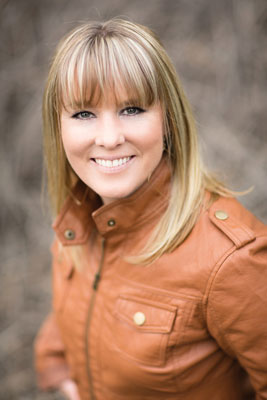 Celebrate! Napa Valley is a 501(c)(3) nonprofit organization with a mission “to enrich our community, preserve our traditions and cultivate connection through the celebration of our heritage and culture.” Christy Gentry, the publicist for both Napa County and Sonoma-Marin fairgrounds, says that with a new vision and leadership, the organization is “moving beyond the former mission that was based on stewarding the property, to focus on preserving the Napa County Fair events while still maintaining the original Fair Association’s traditions and values.”
Celebrate! Napa Valley is a 501(c)(3) nonprofit organization with a mission “to enrich our community, preserve our traditions and cultivate connection through the celebration of our heritage and culture.” Christy Gentry, the publicist for both Napa County and Sonoma-Marin fairgrounds, says that with a new vision and leadership, the organization is “moving beyond the former mission that was based on stewarding the property, to focus on preserving the Napa County Fair events while still maintaining the original Fair Association’s traditions and values.”
Beginning in 2014, the multi-day fair transformed into a celebration of life in Napa Valley consisting of four main events: ENGAGE Art Fair in April; a duo-culture Fair and Fiesta around Cinco de Mayo; a Fourth of July fireworks display and parade; and a Christmas Faire (the 50th annual iteration takes place this year) with its own series of activities, like a gingerbread house contest and holiday arts and crafts workshops for children and adults. Collaborative events take place throughout Calistoga and draw participation from all the Napa County towns.
“Every fair is a reflection of its community,” Gentry says. “And the evolution of the Napa County Fair is to maintain multi-generational participation, sharing of talent, and the passing on of agricultural knowledge to our youth through educational attractions. There are still all the features people connect to a traditional county fair, like a carnival, entertainment, a multitude of exhibits, and the very popular Napa Valley Olive Oil competition. The Fiesta adds the jaripeo (Mexican bull riding), a mariachi band and Ballet Folklorico.”
Gentry was hired “right out of Sonoma State” by the Sonoma County Fair. She had gone back to school after a decade career in accounting to major in marketing, and is now an enthusiastic promoter of the economic and social benefits of fairs through her boutique communications firm, Insite Marketers. “Fairs are home to many firsts, but at the top of the list is a first job. It’s a great opportunity for teens to practice responsibility and team work in a concentrated time period, where they are certain to gain valuable life skills,” Gentry says. “Many first dates happen at the fair. It may be the first big concert you attend, or the first time your parents let you out on your own with your friends. Good security is at the core of a fair’s planning to provide a fun, safe environment for all members of the family—from toddlers to grandparents.”
Fairs also bridge the gap between misconception and reality about how food is produced, says Gentry, demonstrating the role that farming and animals play, directly and indirectly, in our daily lives. What is it like for a child to see and touch a cow and understand where milk comes from?
The 2015 Economic Impact Study reports the Napa County Fairgrounds generated approximately 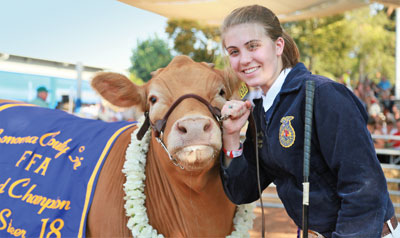 $8,654,000 in spending activity alone, benefiting the local economy and creating a ripple effect of economic benefits. The equivalent of 74 jobs was created as a result of the spending by the fairgrounds, its support businesses and its attendees. The labor income generated by these additional jobs was approximately $2,897,000. The entire year of activities at the Napa Fairgrounds also generates business tax revenue. We can assume that the direct and indirect ripple effect spending represents a significant economic impact, and will continue to do so—for all the featured fairs.
$8,654,000 in spending activity alone, benefiting the local economy and creating a ripple effect of economic benefits. The equivalent of 74 jobs was created as a result of the spending by the fairgrounds, its support businesses and its attendees. The labor income generated by these additional jobs was approximately $2,897,000. The entire year of activities at the Napa Fairgrounds also generates business tax revenue. We can assume that the direct and indirect ripple effect spending represents a significant economic impact, and will continue to do so—for all the featured fairs.
Cloverdale Citrus Fair
Attendance: 15,000-17,000
Revenue: $200,000 (if include the Wine Competition and non-fair events: $1.2 million)
Number of exhibits: 1,400
Number of entries in Wine Competition: 7,000
Number of hires just for the fair: 20
Total prize money awarded: $16,000
Size of grounds: 7 acres
The first fair of the year 2020 will happen in February on President’s Day weekend, rain or shine. The Cloverdale Citrus Fair, now the ripe old age of 127, was established to celebrate the abundant citrus crop that was once part of the northern Sonoma County landscape. It is one of only two fairs in the state dedicated to oranges, lemons, limes and grapefruit.
 Tourists taking the train north in the late 1890s first encountered the fair’s fruit displays as wooden frameworks with a few oranges affixed. These displays have evolved to elaborate three-dimensional exhibits, called “Features,” requiring a minimum of 90 dozen citrus fruits (in the adult category) or 40 dozen (in the youth category). Cash awards for citrus fruit displays totaled $14,700 this year. Flat exhibits, called “Sculptures,” are 4 feet by 8 feet in size, require a minimum of 240 citrus fruits and also have two age categories with cash prizes. All exhibits must be covered in some kind of food product in addition to the citrus and adhere to a theme, which in 2019 was “Making of America.”
Tourists taking the train north in the late 1890s first encountered the fair’s fruit displays as wooden frameworks with a few oranges affixed. These displays have evolved to elaborate three-dimensional exhibits, called “Features,” requiring a minimum of 90 dozen citrus fruits (in the adult category) or 40 dozen (in the youth category). Cash awards for citrus fruit displays totaled $14,700 this year. Flat exhibits, called “Sculptures,” are 4 feet by 8 feet in size, require a minimum of 240 citrus fruits and also have two age categories with cash prizes. All exhibits must be covered in some kind of food product in addition to the citrus and adhere to a theme, which in 2019 was “Making of America.”
Katie Fonsen Young, chief operating officer of the Cloverdale Citrus Fair, says that techniques and skills for wiring the fruit and creating the exhibits have been “passed on from the beginning.” The event is a source of camaraderie and cooperation as well as good-natured competition—civic groups like the local Rotary, Kiwanis and Lions clubs as well as school classrooms, Girl Scouts and other youth groups work on their designs and entries for months in advance. The Citrus Fair provides the boxes of fruit, sourced by Nor Cal Produce from orchards in Visalia and Reedley, and the construction begins on-site in the exhibit hall several weeks before the fair opens.
In addition to Cloverdale’s unique mission to honor citrus, all the familiar elements are here: a carnival, livestock showing, entertainment, exhibits for all manner of homespun arts, shopping opportunities, a baby derby and even a Queen Pageant, which is more than 90 years old. Judged on talent, presence, and appearance, young women from Cloverdale and Geyserville compete for $3,600 in scholarship money.
Young says that the fair attracts 15,000 to 17,000 visitors. “Even when it rains, the community supports its fair. I hear from locals that fair days are like a reunion for friends and family. And folks who have moved away from the area come back on Citrus Fair weekend; grandparents return with their children and grandchildren in tow.”
One of the fair’s greatest revenue sources—now more than $700,000, according to Young—is the wine competition. Founded in 1983 as the Cloverdale Citrus Fair Wine Competition, it has grown into the nation’s largest competition of North American wines. In 2000, it became the San Francisco Chronicle Wine Competition (SFCWC) after a title naming sponsorship agreement with the newspaper, and currently includes entries from the U.S., Mexico and Canada.
“In January, we had 65 wine judges from across the nation at our fairgrounds tasting more than 7,000 wines,” Young says. “We used to host the public tasting of medal-winning wines at the fairgrounds, but the wine event has grown so much that now the award tasting happens at Fort Mason in San Francisco; we had 2,000 guests this year. We do host a special tasting of the double gold winners on Saturday and Sunday afternoons of the Citrus Fair. Because both events happen on the same weekend, we have two teams handling the simultaneous tastings—one team here in Cloverdale and one in San Francisco.”
The Cloverdale Citrus Fair also has additional sources of revenue: an RV Park; RV storage space; rental space for weddings, fundraisers, community events; and discounted rates for nonprofit events. The facility also serves as an emergency evacuation center, and was utilized most recently during this winter’s Sonoma County floods.
The 2015 Economic Impact Study for California’s Fairgrounds reports that the Cloverdale facility’s offering of cultural, educational and agricultural activities generates a wealth of tangible benefits, including $4,739,000 in spending activity alone in 2015—the equivalent of 56 jobs created as a result of spending by the fairgrounds, its support businesses and its attendees. The labor income generated by these additional jobs was approximately $1,798,000.
Sonoma County Event Center at the Fairgrounds
Fair attendance: 220,000
Revenue (Fair): $5,156,000
Revenue (Racing): $1,032,400
Total number of exhibits: 10,218
Number of livestock exhibits: 4,928
Sales total livestock auction: $1,659,374.75
Total awards: $246,810.75
$9,500 in scholarships to 7 youth studying agriculture
Temporary hires just for the fair: 600
Size of grounds: 200 acres
The Sonoma County Fair may not be the oldest of the North Bay fairs, but it runs the longest at 11 days in high summer—this year from Thursday, August 1 through Sunday, August 11. It attracts the most visitors and generates the highest revenues. In 2018, fair and horse racing revenues combined for a total $6,188,400. While the purpose of each North Bay fair is to promote and preserve agricultural heritage, to educate youth and to celebrate community, the mission statement of Sonoma County Event Center at the Fairgrounds specifically states its intention to “contribute to the economic development of our service area by utilizing our fairgrounds for attractive and financially responsible programs and events on a year-round basis.”
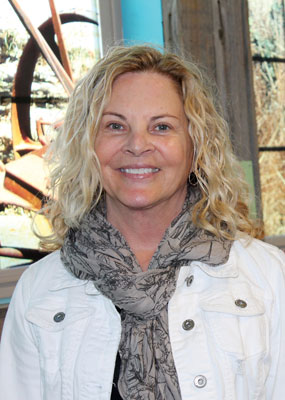 CEO Becky Bartling says, “The economic impact of our facility has grown quite a bit since 2015. In addition to the fair days, we have the cannabis events, Emerald Cup and High Times; we have the huge music festival, Country Summer, the Harvest Fair and the Heirloom Festival. We’re also starting to produce some significant business-to-business cannabis events, in addition to the home shows, sports shows, antique shows and events such as the 20-30 Club’s Battle of the Brews.” Bartling adds that the new economic activity impacts the transient occupancy tax—a tax paid by travelers—and sales tax. These major events combined with 200-300 smaller events yielded $3,864,500. The Jockey Club off-track betting and the Fairgrounds RV Park are also income sources that add to that total.
CEO Becky Bartling says, “The economic impact of our facility has grown quite a bit since 2015. In addition to the fair days, we have the cannabis events, Emerald Cup and High Times; we have the huge music festival, Country Summer, the Harvest Fair and the Heirloom Festival. We’re also starting to produce some significant business-to-business cannabis events, in addition to the home shows, sports shows, antique shows and events such as the 20-30 Club’s Battle of the Brews.” Bartling adds that the new economic activity impacts the transient occupancy tax—a tax paid by travelers—and sales tax. These major events combined with 200-300 smaller events yielded $3,864,500. The Jockey Club off-track betting and the Fairgrounds RV Park are also income sources that add to that total.
“It’s a transition for most communities to think of their fairgrounds as entrepreneurial,” says Bartling. “But it was a necessary evolution as money sources from the state of California dried up. At the time that Governor Schwarzenegger cut money for fairs that had been put in the general fund, it looked like 10 fairs were in danger of going out of business. But I believe none of them did, because they adapted. The community came around and supported them; one fair got a sales tax passed to help. They clearly understood that fairs affect the small people—the guy who sells hot tubs, the guy who sells hats. Money from the fair trickles down.”
Bartling is hoping the 82nd annual Sonoma County Fair, themed “Back to Our Roots in Cowboy Boots” will have the same number of sponsors or more as last year (62 businesses and 28 media sponsors). The fair hires 600 people to work on a temporary basis. That doesn’t include those who work for 58 food vendors, about 60 people hired by security companies and more than 100 for the carnival.
 Heather Borck, the exhibits manager for the fair, adds, “The other connection we have to the business community is with our Junior Livestock Auction. We had over 700 buyers in 2018, totaling $1,659,374 in sales. Some of those are individuals, and others are commercial.” How the Sonoma County Fair differs from the other neighboring fairs is that, in the junior area, there are some market animals and some breeding animals. For Borck, being a strong partner with FFA and 4-H is an essential component of the fair. “From their livestock projects, the kids learn important life-skills like time-management, leadership, problem-solving,” she says. “And for the public, we are teaching food and farming literacy, so children, and all people, can see and understand the importance of it.”
Heather Borck, the exhibits manager for the fair, adds, “The other connection we have to the business community is with our Junior Livestock Auction. We had over 700 buyers in 2018, totaling $1,659,374 in sales. Some of those are individuals, and others are commercial.” How the Sonoma County Fair differs from the other neighboring fairs is that, in the junior area, there are some market animals and some breeding animals. For Borck, being a strong partner with FFA and 4-H is an essential component of the fair. “From their livestock projects, the kids learn important life-skills like time-management, leadership, problem-solving,” she says. “And for the public, we are teaching food and farming literacy, so children, and all people, can see and understand the importance of it.”
With FFA and 4-H involvement, youth who don’t live on farms can still raise animals through their school farms or friends. Additionally, they are exposed to a variety of agricultural careers outside of livestock, including soil science, agricultural economics, farm management, or farm journalism and marketing. “The 4-H includes a large science and technology focus. There are still traditional things like food preservation and sewing, but 4-H also has a robotics program. There are many opportunities for learning,” Bartling says. “I’m thinking of the story of two girls who got lost in the woods and attributed their ability to stay alive from what they learned in 4-H.”
The future of fairs
The annual fair is still the largest moneymaker for the fairgrounds. And to keep revenues flowing, says Bartling, she must find activities that appeal to the residents near each particular fairground. “Our conversations are about asking who are the people coming to the fair and who are the people not coming? We look at surveys, the popularity of certain interim events. We see that the Rodeo sells out every year, and that Monster Trucks and the Destruction Derby are very popular. Our Butler Amusements is excellent, and the rides are getting more spectacular. Other attractions fluctuate with tastes and trends.”
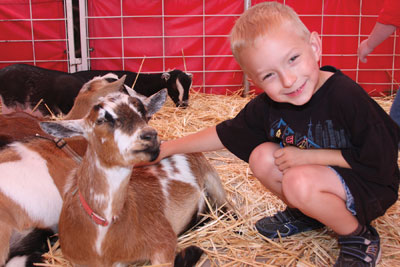 Both Bartling and Borck agree that the entertainment demographic is changing, and technology has affected not only the marketing of the fair, but also the exhibits and the competitions. “The young people are tech-oriented,” says Borck. “Social media, Instagram, Facebook—we had Snapchat fair filters and a racing filter last year. Our contests and exhibits might reflect what is trending on Pinterest. Youth robotics and youth Legos are popular. We’re always trying to come up with interesting ideas in our adult industrial arts and metal sculpture categories—anything that encourages people to share their creations. Just shy of 3,000 people are going to exhibit something.” Adds Bartling, “We have a Collections category, and once, in Del Mar, someone brought in a collection of their cat’s hair balls. It’s crazy things that catch people’s attention!”
Both Bartling and Borck agree that the entertainment demographic is changing, and technology has affected not only the marketing of the fair, but also the exhibits and the competitions. “The young people are tech-oriented,” says Borck. “Social media, Instagram, Facebook—we had Snapchat fair filters and a racing filter last year. Our contests and exhibits might reflect what is trending on Pinterest. Youth robotics and youth Legos are popular. We’re always trying to come up with interesting ideas in our adult industrial arts and metal sculpture categories—anything that encourages people to share their creations. Just shy of 3,000 people are going to exhibit something.” Adds Bartling, “We have a Collections category, and once, in Del Mar, someone brought in a collection of their cat’s hair balls. It’s crazy things that catch people’s attention!”
Weather it’s showcasing such a strange spectacle, with the World’s Ugliest Dog Contest at the Sonoma-Marin Fair being another prime example, or featuring the latest technology, local fair leadership continues to search for ways to preserve the heritage this agriculture-rich area is accustomed to experiencing every summer. “We need to research what people are interested in and be creative in making it happen,” says Bartling. “As the community changes and evolves, so do we.” And in turn, a decades-long, cultural tradition is justifiably and progressively preserved.
North Bay Fairs Timeline
Mark your calendars! From the season’s kick-off in Cloverdale on President’s Weekend to the Calistoga Holiday Village, you can enjoy traditional Fair fun throughout the year.
February: Cloverdale Citrus Fair (February 15-18, 2020)
April: Celebrate Napa’s ENGAGE Art Fair (April 3-5, 2020)
May: Celebrate Napa’s Fair and Fiesta (May 1-3, 2020)
June: Sonoma-Marin Fair (June 24-28, 2020)
July 4th celebrations at the fairgrounds in Calistoga, Petaluma and Santa Rosa
August: Sonoma County Fair (August 1-11, 2019)
December: Celebrate Napa’s Christmas Faire (December 7, 2019)
An asset in times of emergency
In addition to hosting gatherings and events, fairgrounds are also designated emergency evacuation centers for their communities. Because they are accustomed to handling large crowds on a regular basis, fair staff can be nimble in responding when the call comes in the middle of the night from the California Office of Emergency Services, asking for assistance. Allison Keaney, chief executive officer of the Sonoma-Marin Fairgrounds got such a call during the Tubbs Fire in October 2017.
“We know our capacity and our systems are in place, from establishing vet checks before we let animals onto the property, to our ongoing relationships with the local feed stores. This place was able to accept evacuees in a matter of hours” Keaney says. “FFA students from Petaluma High School volunteered to help and we were ready to go. It was an incredible thing. We were activated again in July of 2018 with the Lake County fires. There are currently two emergency boxes in our livestock office—one for people, one for animals, and literally we open the lid and there is a quick start guide listing the first people to call.”
Becky Bartling, chief executive officer of the Sonoma County Fairgrounds and Event Center, started her career at the Del Mar Fairgrounds. Her experience with the San Diego County wildfires in 2003 and 2007 prepared her well for the massive emergency mobilization in October 2017.
“On site we had Cal Fire, the California National Guard, Salvation Army and the Red Cross. The team here was amazing,” Bartling recalls. “Unless you saw it, I don’t think people realized how busy Sonoma County Fairgrounds was during that time. We had all the evacuated animals plus over 1,000 people staying here. I slept in my office with my partner and two dogs for seven or eight days.”
Local fairgrounds are adapting and thriving. There is no doubt that expansion of the various facilities into emergency hubs and event centers will be a huge benefit to their communities and of vital service to the surrounding areas.


